High-visibility of aircraft and surrounding structures is everything, both on the ground and mid-air. That’s why, FAA lighting requirements for aircraft and aviation safety were made, to enhance aircraft appearance, guide pilots during low-visibility conditions, and to prevent collisions.
And that’s what exactly we’ll explain in this guide. In this blog post, you will learn the basics of FAA lighting requirements for obstruction marking, aircraft, runways, and tall buildings. By the end, we will also answer a few most asked questions related to the FAA lighting system.
What are FAA Lighting Requirements For?
FAA (Federal Aviation Administration) lighting requirements are basically designed considering safety of the entire aviation system. These regulations mandate that how facilities should mark tall structures (buildings, towers, chimneys), runways, and aircraft using various lighting systems.
The aim of these regulations is to make tall structures and other aircraft highly visible to pilots. Plus, ensure that aircraft are clearly visible to other aircraft, ground personnel, and air traffic controllers.
FAA Lighting Requirements for Aircraft and Other Structures
Federal Aviation Administration (FAA) has designed and established detailed lighting requirements, standards and regulations for aircraft, runway, and tall structures marking. Apart from the FAA, FCC and ICAO have also dictated strict rules and laws for aviation safety.
But in this guide, we will mainly focus on FAA light requirements. So, let’s get started.
What are FAA Aircraft Lighting Requirements?
The aircraft lighting requirements FAA dictates that different types of lighting should be used on aircraft for high-visibility and to avoid mid-air collisions. Here’s the basic overview of all airplane lighting requirements and how you should install these lights:
Position (Navigation) Lights:
- Position lights should be installed at the forward and rear ends of the aircraft.
- In the forward position, you should install a red (on the left side of the plane) and green light (on the right side of the plane).
- At the rear position, white color lights should be installed at the plane tail or edge of wings.
- As per FAA, a plane should only operate during the sunset to sunrise period, unless it has positioned lights.
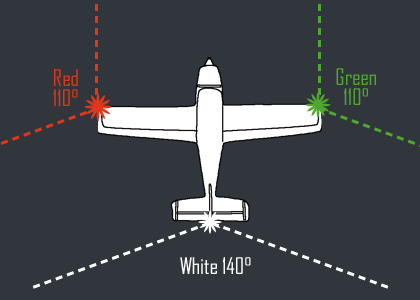
External and Cockpit lighting:
- To light cockpit and airplane external, whether you install any position or anti-collision lights, they must have good flash rate, intensities, colors and fields of coverage. Because lights with these capabilities are bright enough and give other pilots signals from far distance, avoiding aircraft collision.
- When you use position lights, ensure to install red light on the left, green on the right’s side, and white at the tip of the airplane.
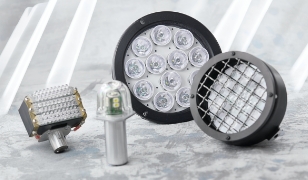
FAA Anti-Collision Light Requirement:
- Anti-collision lights (or beacon) light should be used all time whenever the aircraft’s engine is operating. However, these lights should not be used if the pilot gives commands that turning them off is more safe under certain conditions (like fog, etc.)
- Facilities must use approved-anti-collision (beacon) light that are in a red color and meet FAA color specification requirements.
Landing Lights:
- Landing lights must be installed on all airplanes. Because these lights may reduce the effect of glare objects that could disrupt pilot visibility. Also, these lights provide enough light during landing at nighttime.

Wing Icing Inspection Lights:
- Wing icing detection lights, you should install them on those airplanes with permits to fly during nighttimes where icing on wings can be possible. Make sure, you use glare-free wing inspection lights so that the lights’ reflection does not disturb the pilots and crew from doing their job.
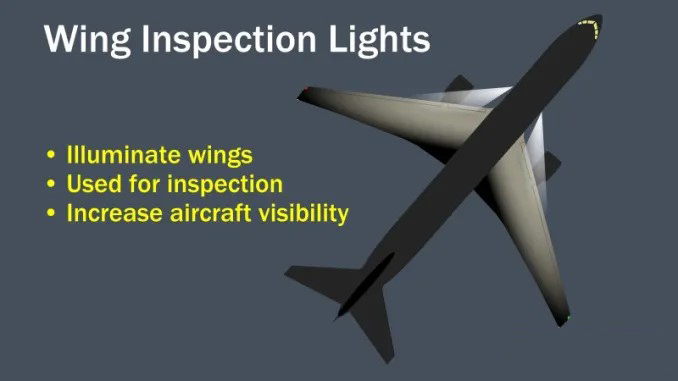
Airplane Emergency Exit Lighting
Based on 14 CFR 25.812, 14 CFR 121.310:
- Emergency lighting system must be installed to a separate lighting system from the other cabin lights.
- You must ensure that the internal passenger cabin lighting should be at least 0.05 foot‑candle average along aisles at 40″ intervals, with a minimum of 0.01 foot‑candle.
- Whereas, the floor proximity lighting near the floor (within 6″) should be at minimum 0.02 foot‑candle to guide evacuation if overhead lights fail.
- At each overwing exit, at least 0.03 foot‑candle must illuminate a 2‑sq‑ft area below the exit.
- Emergency exit lights must be activated automatically or manually by crew during taxi, takeoff, landing, or power loss.
- Lighting levels must be maintained for at least 10 minutes after an emergency landing under extreme temperatures.
- FAA has also mandated that an electrical-powered exit signs should also be installed in an aircraft under 25.811(d)(2) with red letters ≥ 1½″ on illuminated background, ≥ 10:1 contrast, internally lit to ≥ 25 ft-L.
- You should also ensure that each passenger emergency exit must be placed near the exit spot so it is clearly visible from 30″ away.

Airplane Lights Diagram
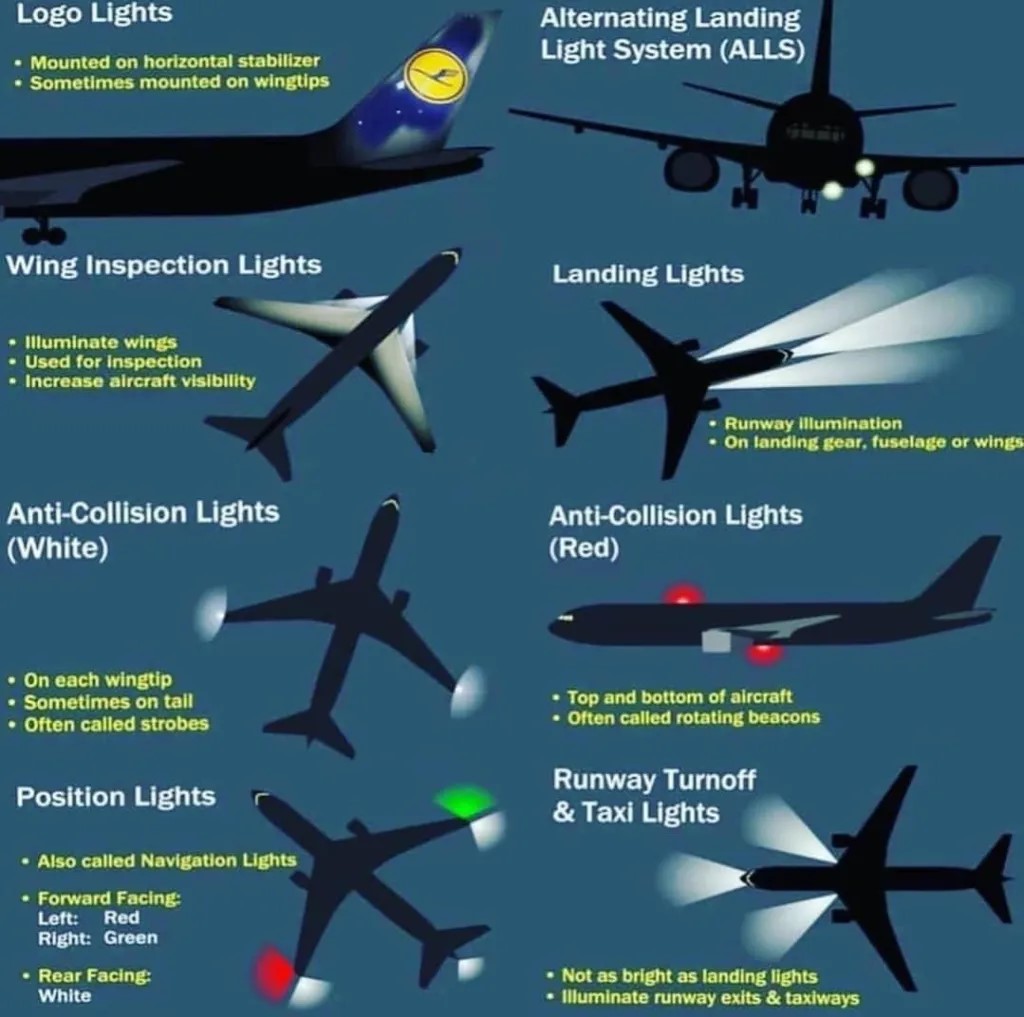
What are Aviation Obstruction Lights?
Aviation obstruction lights (often called tower obstruction lights) are basically optical devices that emit high-intensity red color lights (often white). These lights are generally installed on tall structures to make them highly visible to pilots. That way, pilots easily identify the potential hazard of collision from a far distance and navigate around those heightened structures safely.
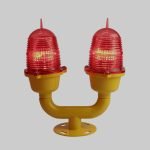
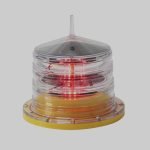
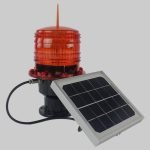
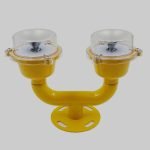
What are FAA Obstruction Lighting Requirements?
Based on FAA Advisory Circular 70/7460-1M and 14 CFR Part 77, here are the requirements and regulations for aviation obstruction marking and lighting:
FAA Lighting Requirements for Towers and Other Obstructions
Structure to be Lighted and Marked:
- Every structure or appurtenances with overall height 200 ft (61 m) AGL or that exceed this threshold should be marked and lighted.
- On the other hand, structures < 200 feet (60.96 m) AGL and not meeting obstructions standards mentioned in 14 CFR Part 77, should also be lighted (based on geographic locations).
Obstruction Lighting System Requirements:
FAA Red Obstruction Lights Requirements:
FAA recommends using aviation red aircraft warning lights on structures for nighttime marking. These lights generally come in two types: Steady-burning and flashing red lights. Use the following guidelines to mark tall obstructions with these lights:
- To mark structures that are equal or less than 150 feet (45.72 m) AGL, you should use two or more steady-burning red (L- 810) lights. And mount them diagonally or diametrically at the structure’s top.
- For marking structures >150 feet (45.72 m) AGL but less than 350 feet (106.68 m), use two or more red (L-810 F) flashing lights and install them in a diagonal position at the rate of 30 flashes/ minute.
- However, to mark structures > 350 feet (106.68 m), use two flashing (L-864) red lights and install them opposite to each other.
- To mark appurtenances equal or less than 40 feet (12.19 m) such as rod, antenna, or other equipment, use one red flashing light and install that at the top. If it’s not possible to mount at the top, then use additional red flashing lights and mount them at the base.
- To mark light appurtenances > 40 feet (12.19 m), use one or more red lights and mount them on a supporting mast. Make sure to place the mast along with appurtenances to provide a clear view.
FAA Medium-Intensity Flashing White Obstruction Lights:
As per FAA, medium-intensity flashing white lights are recommended for use during daytime operation. And for nighttimes, you will need to install them along with an automatic reduced intensity system. Let’s discuss this system’s requirements.
- To mark appurtenances equal or less than 40 feet (12.19 m) such as rod or antenna, install a medium-intensity flashing white light exactly at the base of appurtenances.
- To mark appurtenances > 40 feet (12.19 m), use two medium-intensity flashing white lights and install them within 40 feet (12.19 m) of appurtenances to provide clear view.
- For marking structure 200 feet (60.96 m) AGL, use two or more (L-865) lights and install them diagonally.
- Note that, when installing these lights on structures with height between 200–700 feet (60.96 m-213.36 m) AGL for less than 24-hours use, FAA restricts using any other marking method.
- But to mark structures > 700 feet (213.36 m) that may be used during nighttime, twilight, and 24/7, FAA strictly dictates painting the structure with orange and white paint along with installing medium-intensity lights.
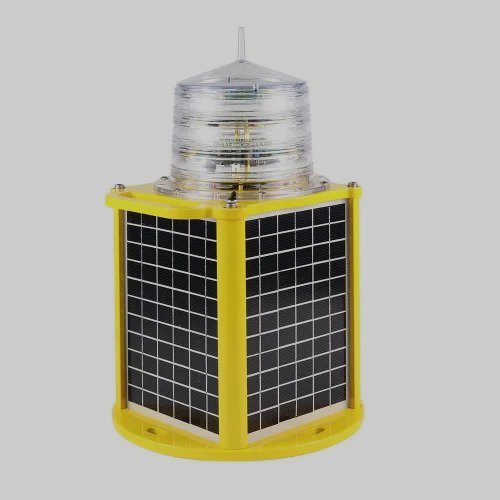
FAA High-Intensity Flashing White Obstruction Lights:
Note: FAA prohibits using High-flashing white lights in urban and high-population and recommends installing dual-lighting system instead.
Let’s discuss high-intensity flashing white light regulations:
- To light or mark an antenna or similar appurtenance > 40 feet (12.19 m), use a high-intensity white flashing (L-856) light and mount that within 40 feet (12.19 m) from the tip of the appurtenance. Make sure that the light is operational 24/7.
- To marking several extensive building or such structures that are located in the same area with the maximum 150 feet (45.72 m) apart, here’s what FAA recommends about lighting requirements in this case:
- To mark structures that are 200 feet (60.96 m) or less in either horizontal dimension, install three or more high-intensity lights at the very top of the structure.
- Whereas, the structure > 200 feet (60.96 m) in one horizontal dimension or is 200 feet (60.96m) or less in the other, install two light units adjacent to each other at the midpoint of the structure edge.
- To mark structures > 200 feet (60.96 m) in both horizontal dimensions, install multiple high-intensity lights and thoroughly spaced them at obstructions with regular intervals of 100 feet (30.48 m).
Important: FAA has clearly mandated that all lights after they are installed on obstructions must be shielded. Because these lights provide high-level brightness intensity that can impact locals living in the area.

Dual Lighting:
Dual lighting obstruction marking system is basically a combination of red (L-864) for nighttime warning and high- or mid-intensity flashing white lights for daytime and twilight use. As we mentioned earlier, the FAA recommended installing this system in urban areas. Let’s discuss what FAA has dictated about the dual-lighting requirements:
- On appurtenance > 40 feet (12.19 m), L-865 or L-856 and a flashing red light (L-864) should be installed within 40 feet (12.19 m) at the top of appurtenance.
- To mark structures that are equal or less than 700 feet (213.36 m) AGL, no other marking methods should be used in any case.
- While marking structures > 700 feet (213.36 m) AGL, red and high-intensity flashing white lights (L-856) should be installed on the structure’s top.

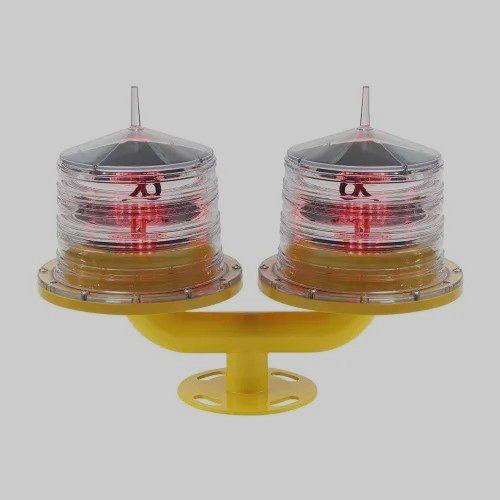
FCC Tower Lighting Requirements
According to FCC (Federal Communications Commission) mandated tower and lighting requirements:
- Any facility planning to install a high-intensity flashing white lighting system, along with red light or painting on a structure, antenna, or a tower, located in residential neighborhoods, must prepare and submit an environmental assessment beforehand for approval.
- FCC has also mentioned that if someone wants to build a tower taller than 2,000 feet AGL, they must prove and provide very strong reasons to get approval. Because both the FAA and FCC strongly discourage such heightened towers that could pose a danger to aviation safety.
- The FCC has also stated that if a new tower or antenna construction is proposed to construct, the FCC only approves once the FAA confirms that the antenna will not pose any hazard to aviation safety.

FAA Crane Height Restrictions
- FAA has clearly stated that no crane can exceed 200 feet in height AGL that are placed within 5.00 miles or nearest point of an airport runway. If there’s high need to increase the crane height, the concerned department needs to ask for a permit from FAA.
- Regarding the above permit, FAA has also stated that a concerned facility must provide them a Form 7460-1 before 30 days of: the date when proposed construction work is to start or the expected date when construction permit is to be filed.
Radio Tower Painting Requirements
Based on obstruction painting requirements mandated in FAA advisory circular:
- The paint on the tower should be applied prior or immediately after the construction.
- Radio towers should be painted in alternate bands of aviation orange (Federal Standard 595, color #12197) and white (Federal Standard 595, color #17875) color.
- Regardless of the tower’s height, the painting bands on the tower should be in odd numbers, of equal width and perpendicular to the vertical axis. Check the below table for reference.
What are FAA Runway Lighting Requirements?
Just like lighting regulations for aircraft and obstruction lighting and marking, FAA has also dictated lighting regulations for runway and such sites. Here’s the basic overview of how runway lighting should be:
- Runway Edge Lights: These should be positioned with a white colored lights in a row, with spacing of 200 feet (61 meters) apart. However, at intersections (the space between one runway and taxiway/runway), edge lights must be placed with a 400-foot gap. Also, on a runway with ILS functionality, edge lights should be yellow instead of white.
- Runway Centerline Lights: These are required on only Category II/III runways. White lights should be positioned until the last 3,000 ft. While, on the next 2,000 ft, alternating red and white lights should be installed. And in the last 1,000 ft, red lights should be positioned, with spacing of every 50 feet.
- Touchdown Zone Lights (TDZL): These lights must be installed 100 feet before the runway. You will need to install them in total two rows with a group of three white lights on either side of the centerline, and continue to the first 3,000 ft of precision runways.
- Runway End Identifier Lights (REIL): These are primarily flashing white lights. They need to be installed on both sides of the runway threshold to help pilots identify the beginning of the runway.
- Approach Lighting Systems (ALS): These lights are required to be positioned starting from the runway approach area and end at the threshold.
- Runway End Lighting: There are basically two types of lights installed at runway ends: Threshold identification lights (RTIL) and Runway ending lights. On viewing from the approach side, these lights appear green and from the opposite side, they appear red.
- Pilot-Controlled Lighting (PCL): You can install these lights at airports where there are no towers at all. Because these smart lights are operated by pilots using radio mic clicks. So installing them at airports with radio towers may disrupt the lighting functionality.
Why Do Cell Towers Blink White?
Cell towers basically blink white lights to make the towers’ appearance highly visible to pilots, especially in bright sunlight. Basically, the FAA requires flashing white lights on all towers with height 200 feet (60.96m) AGL or more with the purpose of aviation safety.
However, these lights are installed with different intensities (depending on the tower’s height). They are also often used along with red lights depending on the weather patterns and geographical locations.
Why Do Cell Towers Blink Red?
Cell towers primarily blink red lights to alert the pilot flying the aircraft of the tall structure and potential collision hazards, especially during lo-light conditions. These blinking red lights are actually FAA aviation obstruction lights that are strictly required on tall towers for obstruction marking.
By consistently blinking red light, these lights’ signal pilots about the tall structures in its flying route. That way, pilot stay alert and navigate around towers safely and without colliding.
How Tall are Red Lights in Aviation?
According to the FAA Obstruction Marking and Lighting advisory circular, red lights are required on every permanent or temporary structure which exceeds the overall height of 200 feet (60.96m) AGL or obstructions standards mandated in 14 CFR Part 77.
However, red lights are also required on structures less than 200 feet (60.96m) threshold. Such structures generally include airport tower lights or tall buildings existing within the radius of the airport, runways, flight paths, and may pose a collision hazard to planes.
How tall are light towers for planes?
Any light tower that exceeds the height of 200 feet (60.96m) is subject to FAA tower lighting requirements. Even any light towers shorter than this height may also require warning lighting, depending on the terrain capability, geographic location and weather patterns.
For example, using high-intensity flashing white light for 24/7 is prohibited in urban/populated areas. Because these lights often merge with background lighting and pose a confusion to medevac or police officers to spot tall structures.
JACKWIN’s Role in FAA Lighting Requirements for Aircraft & Obstruction Marking
JACKWIN, China’s leading aviation obstruction lights manufacturer and supplier, has been selling obstruction lights since 2008 to 50+ countries. As an all-in-one solution, we offer a complete range of aviation warning lights, varying in color, size, intensity, and application.
Whether you need aviation obstruction lights for communication towers, marines, high-rise buildings, cranes, airports, tall chimneys or airport runways, you name it and we have it.
Our obstruction lights are super bright, energy-saving, rust-free, provide 360° Viewing, impact and weather resistance, and have long-lasting solar-powered batteries.
We can also manufacture a customized aviation obstruction lights solution for your needs based on your requirements, that too at competitive wholesale prices. Contact Us today to get an instant inquiry!


-80x69.png)

